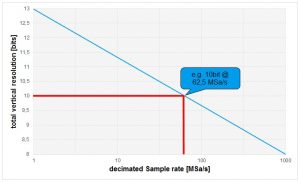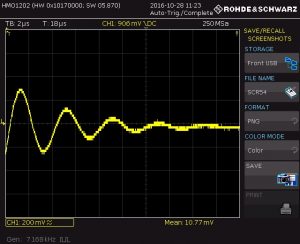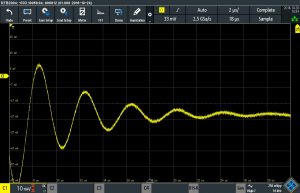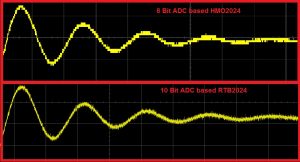
The performance advantages of 10-bit A/D converters in oscilloscopes
By Andreas Grimm, product sales manager oscilloscopes, Rohde & Schwarz
Electronics Test & Measurement Supply Chain A/D converters A/D converters analog-to-digital converters oscilloscopes oscilloscopesHigh vertical resolution of analog-to-digital converters provides more signal details
Today, electronic designs are highly integrated components and are based on various technologies. If you want to measure small parts of signals in the presence of large amplitudes, you need an oscilloscope with a high vertical resolution. Digital oscilloscopes typically have a vertical resolution of 8 bit. But a 10-bit analog-to-digital converter (ADC) has four times more resolution than an 8-bit ADC. You can see signal details much more precisely.
Digital oscilloscopes are essential measuring instruments in electronic research, education and industry. When selecting a suitable oscilloscope, bandwidth and sample rate are often the main factors to consider. Memory depth and usability (including screen size) are further aspects. And in a growing number of applications, more than 8-bit vertical resolution is not only helpful but sometimes also necessary. Besides using A/D converters with a higher resolution, there are several methods available for increasing vertical resolution. Two often-used methods are averaging and high-resolution acquisition modes; both will be discussed in this article.
10 bits mean four times more resolution
Since their introduction, digital oscilloscopes have been equipped with A/D converters, which typically have an 8-bit resolution. This was mainly because there was no technology available for making higher-resolution A/D converters with the necessary sample rate and low noise. Furthermore, only high-end oscilloscopes commonly use manufacturer-specific A/D converters, while for cost reasons entry-level scopes usually have off-the-shelf A/D converters. The latter are generally not state of the art.
Today there are A/D converters available with 10-bit or even 12-bit resolution and sample rates, which typically support bandwidth up to 1 GHz. Still, the higher price compared with 8-bit components has up to now prevented their use in instruments with a starting price of less than about EUR 5,000. The new R&S RTB2000 oscilloscopes use the proprietary 10-bit A/D converter that Rohde & Schwarz originally developed for the R&S Scope Rider, the industry’s first isolated portable, multifunctional oscilloscope with options such as MSO and serial triggering and decoding of serial protocols. Using this proprietarily developed component in the R&S RTB2000 makes it possible to achieve a significantly higher vertical resolution compared with oscilloscopes that have an 8-bit A/D converter, while keeping the starting price at EUR 1,250.
Today, because voltage levels keep sinking and power supply efficiency requirements continue to rise, the tolerances when measuring electronic circuits are decreasing. As a result, the more accurate and the higher the resolution for voltage measurements, the better for the engineers. The following table shows the difference between 8-bit and 10-bit resolution. The example calculation for a 1 V signal yields a resolution of around 1 mV for the 10-bit converter. Developers who want to analyze signals of power electronics or who work with high dynamic ranges benefit from the signal measured with a resolution that is four times higher.

8-bit ADC vs. 10-bit ADC resolution.
To make effective use of these smaller signal details, the oscilloscope must have a sufficiently low-noise frontend. For example, if the oscilloscope had a noise level of 4 mV in the example described above, the higher resolution would not bring any advantage, since it would only digitize the noise of the oscilloscope without revealing extra signal details compared with an 8-bit-based oscilloscope. Therefore, it is important not only to consider the oscilloscope’s resolution but also its noise characteristics.
Methods for increasing vertical resolution
There are different methods for improving the vertical resolution of an oscilloscope, besides using an A/D converter. The two most common ones are averaging and high-resolution (HiRes) acquisition modes.
Averaging of multiple acquisitions
A common method for increasing resolution is the use of averaging. This is typically provided as a math functionality of the oscilloscope. This algorithm relies on averaging multiple consecutive acquisitions. As more acquisitions are averaged, the better the achievable resolution will be. An advantage of averaging is that it also reduces wideband noise, making the representation of the measured signal more accurate. However, there are two important disadvantages of this method:
It takes time to acquire and process the data several hundred times to get the required resolution
It only works with repeating signals, such as clock signals.
Most signals do not repeat periodically, however, which means that averaging over several acquisitions cannot be used.
HiRes – averaging of a single oversampled acquisition
More and more oscilloscopes support special acquisition (sometimes also called decimation) modes, referred to as “HiRes”, i.e. high resolution. This method exploits oversampling, resulting from a higher A/D converter sampling rate than the sampling rate needed for accurate signal reconstruction in line with the Nyquist criteria. The additional samples are averaged and the resulting waveform is displayed. Since averaging is done within a single acquisition, this method yields higher vertical resolution also for nonrepeating events. Theoretically, the gain in vertical resolution is calculated as . The variable N here represents the factor for oversampling. In order to gain e.g. two additional bits, a factor of 16 is required.
If an oscilloscope has a max. sampling rate of 1 Gsample/s and an 8-bit A/D converter, it will have a decimated sampling rate of 62.5 Msample/s at 10-bit vertical resolution in HiRes mode. The following graph shows the relation for this example. This calculation reveals lower digital bandwidth as the main drawback using the HiRes mode.

Vertical resolution enhancement in HiRes mode.
Real-world comparison
After this theoretical discussion of the different methods, the following example will illustrate the effect of higher ADC resolution. The test signal used is an exponentially damped sine function, which is a relatively strong pulse with damped amplitude to both sides. This is a highly dynamic signal, and we will examine the small details. A signal of this type is available as a predefined function in many waveform generators, including the built-in waveform generator of the R&S RTB2000. The signal is connected to an R&S HMO2024, an oscilloscope well known for its excellent low-noise acquisition path with 200 MHz bandwidth. This oscilloscope uses a very good off-the-shelf 8-bit A/D converter. The same signal is fed in to the new R&S RTB2000, the successor of the R&S HMO2024. The R&S RTB2000 includes an integrated 10-bit A/D converter developed by Rohde & Schwarz.

Comparison of the R&S HMO2024 with 8-bit ADC and its successor, the R&S RTB2024 with 10-bit ADC.

It is clearly recognizable that the four times higher resolution of the R&S RTB2000 A/D converter combined with the low-noise frontend gives more detailed information and allows more accurate measurements. If the zoom is set so that vertically and horizontally the same signal segment can be seen in both oscilloscopes, the difference becomes even more visible. On the R&S HMO, you can see the least significant bit of the 8-bit A/D converter, represented by the step-like display.
Conclusion

Zoomed comparison of 8-bit versus 10-bit resolution.
The vertical resolution of an oscilloscope is becoming more and more important due to new applications with lower voltages and smaller voltage differences. This article discussed different methods for increasing vertical resolution beyond the typical 8-bit resolution. In addition, the difference in using an 8-bit vs. a 10-bit A/D converter was explained theoretically and illustrated using a real-world example. It was shown that users of an oscilloscope such as the R&S RTB2000 with a very low-noise frontend and a 10-bit A/D converter can measure considerably more details of a signal than with a conventional oscilloscope equipped with an 8-bit A/D converter.
#
